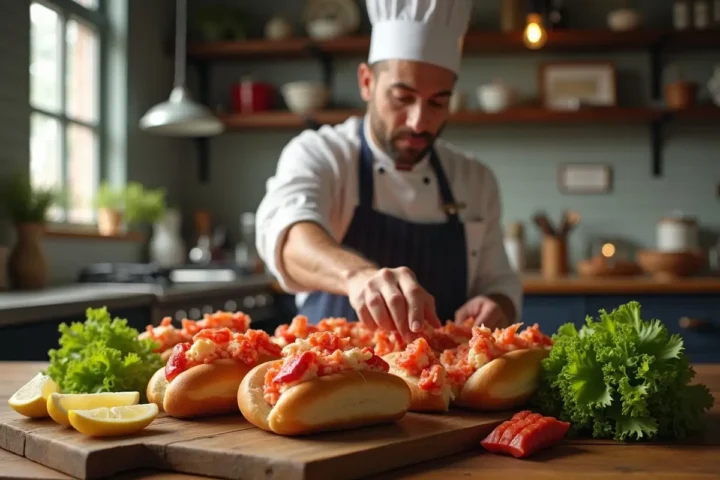Lobster Roll Kits and the Revival of East-Coast Comfort Food
Lobster has always carried a certain East-Coast nostalgia, a taste of salt air and shoreline simplicity. Once a fisherman’s lunch, the lobster roll has become a cross-country obsession, appearing everywhere from food trucks to fine dining menus. And now, thanks to a new wave of lobster roll kits, you don’t have to live near the Atlantic to experience it.
Across Canada, from Halifax to Vancouver, lobster roll kits are turning kitchens into mini seafood shacks. They bring the same buttery, delicate texture of a freshly caught lobster roll straight to your countertop, minus the flight and the wait in line at a seaside shack. It’s part of a larger movement that’s reshaping how we think about regional food: comfort as culture, delivered to your door.

The East-Coast Icon That Started It All
Before the lobster roll became a trending hashtag, it was a humble creation. The first known lobster rolls appeared in Maine and the Maritimes in the early 20th century. Fishermen, too tired to fuss with full shells after a long day, started tossing lobster meat into hot dog buns with butter and a touch of lemon. It wasn’t fancy. It wasn’t plated for aesthetics. But it was perfect.
In Atlantic Canada, the lobster roll became an identity. Each region added its twist. Nova Scotia’s rolls leaned buttery and simple. Prince Edward Island versions often came with a hint of mayo and crisp lettuce. New Brunswick’s roadside diners served theirs chilled, heavy on the meat. Every roll told a story about the coastline, about the balance between thrift and indulgence.
The lobster roll’s enduring appeal lies in its restraint. It doesn’t rely on sauces or sides to impress. It’s a celebration of the main ingredient itself, something East-Coasters have always understood instinctively.
Why Lobster Roll Kits Are Having a Moment
The rise of lobster roll kits feels almost inevitable. Canadians crave experiences tied to authenticity, but they also crave convenience. In recent years, the appetite for “experiential eating” has grown; people don’t just want to eat lobster, they want to re-create the story of it.
Kits meet that desire halfway. They arrive with everything pre-portioned: sweet lobster meat, split-top rolls, seasoning packets, and sometimes even sea-salt butter. All you need is ten minutes and a skillet. The result feels like a treat, yet approachable.
During lockdowns, these kits filled a gap. Giving city dwellers a taste of coastal normalcy when travel was off the table. But even as restrictions faded, demand didn’t. Instead, lobster roll kits found a new identity: a symbol of staycation indulgence and maritime connection.
They fit neatly into the broader Canadian pattern of “culinary memory.” Whether it’s smoked salmon from British Columbia or butter tarts from Ontario, people want to taste where they’re from or where they wish they were.
From Dock to Doorstep
A big part of what makes lobster roll kits remarkable isn’t just the taste. It’s the transformation happening behind the scenes. The lobster industry has evolved dramatically over the past two decades, with sustainability now at the center of how lobster is caught, packaged, and sold.
Atlantic Canada has one of the most regulated fisheries in the world. Lobster harvesters follow strict trap limits, size restrictions, and seasonal protections that help maintain healthy populations. The result is a thriving fishery that supports small coastal communities while respecting marine ecosystems.
Modern kits often source lobster directly from these regulated fisheries, flash-freezing the meat within hours of catch. This preserves quality and minimizes waste. Instead of shipping whole lobsters (heavy, expensive, and environmentally taxing), kits reduce transport emissions by shipping only the edible portion.
It’s local pride meeting modern logistics. Canadians from Alberta to Quebec can now enjoy the same lobster that came out of Nova Scotia waters days earlier, without compromising sustainability.
The Cultural Pull of East-Coast Food
Food has always been a shorthand for geography. When you eat a lobster roll, you’re not just tasting shellfish, you’re tasting salt spray, dock chatter, and sea wind. It’s an edible postcard from the East Coast.
East-Coast food has always had a particular pull on Canadians elsewhere. It represents something grounded and unhurried. Chowder, mussels, cod cakes, and lobster rolls all share one defining trait: honesty. They’re made with what’s available, served without pretense, and rooted in family tradition.
That simplicity resonates in a world where food trends change faster than weather. The lobster roll, with its clean ingredients and focus on quality over embellishment, offers a kind of culinary clarity. And lobster roll kits make that clarity accessible, no matter where you live.
Inside a Modern Lobster Roll Kit
So what exactly arrives when you order a lobster roll kit? Typically, it includes:
- Fully cooked, flash-frozen lobster meat (claw and knuckle pieces)
- New England–style split-top rolls
- Butter or mayonnaise packets
- Lemon wedges or seasoning
- Instructions for assembly
The beauty lies in the details. The split-top rolls are specifically chosen to toast evenly on both sides, creating the golden crust that defines an authentic lobster roll. The lobster meat is pre-cooked but retains its sweetness through careful temperature control during shipping.
Some kits go further, adding extras like coleslaw mix, bibs, or branded spice blends. It’s both meal and an experience. Something you can prepare easily yet still brag about serving.
How Lobster Roll Kits Bridge Coastlines
Canada’s vastness has always made regional food connection tricky. You can’t exactly pop over to Nova Scotia for lunch if you live in Calgary. But lobster roll kits are quietly bridging that divide.
By making regional delicacies accessible nationwide, they foster a deeper appreciation for Canadian maritime culture. They also keep small fisheries and lobster processors thriving. Every box shipped represents a network of people (from lobster fishers to packers to delivery drivers), sustaining a coastal economy that depends on responsible demand.
Food has always been one of the strongest cultural exports. Lobster roll kits extend that story, helping coastal communities share their craft with Canadians who might never set foot on a wharf.
The Psychology of Comfort Food
Part of what makes lobster roll kits so appealing is emotional. Comfort food is about familiarity and belonging. For many Canadians, lobster rolls evoke family vacations, seaside diners, and long drives along the Cabot Trail or Fundy Coast.
When you recreate that memory in your own kitchen, it hits a different kind of satisfaction. It’s not nostalgia in the cliché sense; it’s connection. A reminder that food can still transport you even when travel feels out of reach.
And unlike most comfort foods, lobster rolls strike a balance between indulgence and freshness. They’re rich but not heavy, refined but unfussy. That duality mirrors modern Canadian tastes perfectly: healthy but joyful, local but adventurous.
Reinventing the Maritime Tradition at Home
Lobster roll kits have redefined what it means to cook “at home.” You’re not just reheating something, you’re participating in a tradition. The act of buttering the roll, warming the lobster, and layering it just right connects you to the process.
It’s also an invitation to improvise. Some people add herbs or citrus. Others pair their rolls with craft beer or homemade fries. The kit gives you the base, but the ritual makes it yours.
This mix of tradition and play mirrors the Canadian approach to food: respect for roots, paired with curiosity about how to evolve them.
A Taste That Travels Well
It’s rare for a food to cross regions without losing authenticity, but the lobster roll manages it. Whether eaten on a Halifax pier or a Toronto balcony, it tastes like the coast. That’s the beauty of lobster roll kits. They preserve that maritime purity even as they travel thousands of kilometers inland.
In an age where “fresh” often means local, these kits remind us that “local” can also mean ethically sourced, properly handled, and thoughtfully delivered. They show that national connection doesn’t have to come at the expense of regional integrity.
How to Enjoy the Experience Fully
If you decide to bring the coast to your kitchen, there are a few ways to make the experience feel complete:
- Set the scene: Play some maritime music or open the windows to let in a bit of breeze.
- Toast the rolls properly: Golden and crisp on the sides, soft in the center.
- Don’t oversauce: Let the lobster be the star. A touch of butter or mayo is all it needs.
- Pair it right: A crisp white wine or light beer complements the sweetness of the meat.
- Serve immediately: A lobster roll waits for no one.
Cooking it yourself doesn’t break the magic. It enhances it.
The Future of Regional Food in Canada
Lobster roll kits are part of a larger shift in how Canadians think about national cuisine. We’re moving from “importing flavors” to celebrating regional ones. We want the East Coast’s seafood, the Prairies’ grains, Quebec’s cheese, and British Columbia’s produce. All coexisting, all proudly Canadian.
In that context, the lobster roll isn’t just food. It’s a symbol. It represents how Canadian traditions adapt, survive, and thrive through innovation. The coast finds its way inland, and we’re all a little richer for it.
The Last Bite
A good lobster roll feels effortless. It’s a sandwich that doesn’t need convincing. The meat is sweet, the bread is warm, the butter is perfect. But behind that simplicity lies a story of craftsmanship, sustainability, and culture. One that lobster roll kits are now helping to tell across the country.
Bringing home a kit isn’t about chasing a trend. It’s about honouring a classic, one bite at a time. Whether you live by the sea or far from it, every roll is a reminder that Canadian comfort food doesn’t have to travel far to find its way home.


